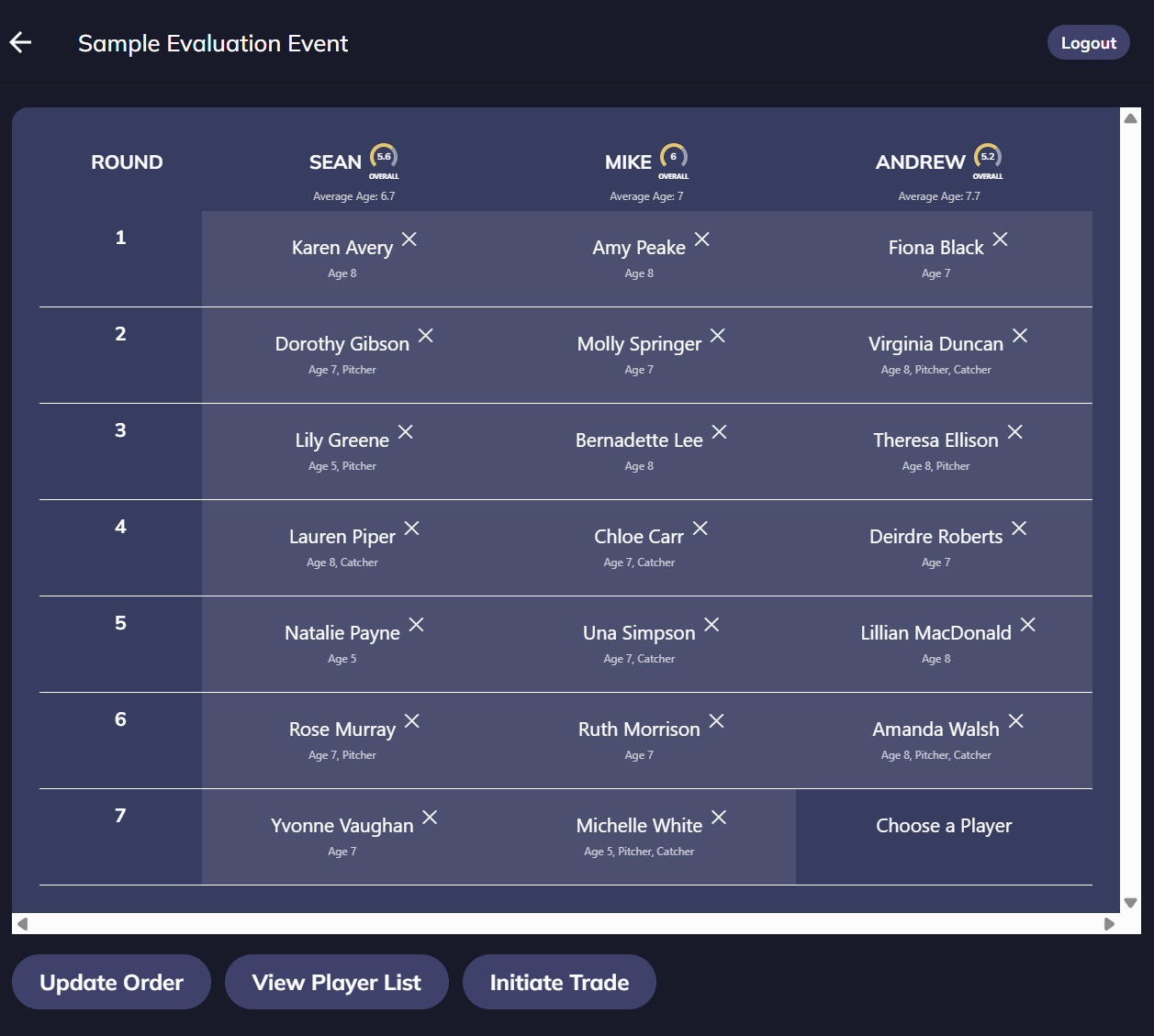Steps to Run a Streamlined Player Evaluation (Without the Chaos)
Steps to Run a Streamlined Player Evaluation (Without the Chaos)
Introduction
Player evaluations are one of the most important steps in running a successful youth sports league. Done well, they set the foundation for fair team assignments, balanced competition, and a positive season. Done poorly, they can feel chaotic, subjective, and unfair to both players and parents.
Here’s how to set up and execute a streamlined, transparent evaluation process—and how tools like Tidepool Sports can help.
1. Define Clear Evaluation Criteria
Start by identifying the core skills that matter most for your sport (e.g., hitting, fielding, speed, teamwork).
Keep it simple and consistent—too many categories can overwhelm evaluators.
Example: For baseball, you might focus on 5 categories scored 1–5.
How Tidepool Helps: Categories are fully customizable, so your league decides what matters and sets the scoring scale.
2. Standardize the Scoring System
Every evaluator should be using the same scoring method.
Provide a quick calibration session before evaluations (e.g., “what does a ‘3’ in hitting look like?”).
Avoid open-ended notes without structure—numbers make data easier to compare.
How Tidepool Helps: Our mobile app ensures evaluators enter consistent ratings in real time, eliminating messy paper forms and spreadsheets.
3. Train and Empower Evaluators
Hold a short training session before evaluations begin.
Give evaluators clear roles (station leader, skills tester, scorer).
Encourage fairness and remind them of the goal: balanced teams.
How Tidepool Helps: Evaluators can use their phones or tablets at each station, instantly syncing data to the league database.
4. Eliminate Bottlenecks
Stagger players through multiple stations to avoid backups.
Use multiple evaluators for larger leagues to speed up the process.
Keep parents informed of timing to reduce stress.
How Tidepool Helps: Real-time syncing means no waiting for data entry. Coaches and admins see results immediately.
5. Review and Validate the Data
Before the draft, review scores to confirm no errors or missing data.
Look for trends across evaluators to catch inconsistencies.
Share evaluation summaries with your board for transparency.
How Tidepool Helps: Reports are automatically generated, so you can sort, filter, and analyze data instantly.
Conclusion
A great evaluation process doesn’t just save time—it builds trust. Parents know their players were fairly assessed, coaches feel confident in the data, and leagues avoid the headaches of uneven teams.
With Tidepool Sports, leagues streamline evaluations, increase fairness, and eliminate manual data entry. More importantly, you build a foundation for a fun and balanced season.
Player evaluations are one of the most important steps in running a successful youth sports league. Done well, they set the foundation for fair team assignments, balanced competition, and a positive season. Done poorly, they can feel chaotic, subjective, and unfair to both players and parents.
Here’s how to set up and execute a streamlined, transparent evaluation process—and how tools like Tidepool Sports can help.
Steps & Best Practices for Preparing and Running a League Draft
It all begins with an idea.Steps & Best Practices for Preparing and Running a League Draft
Introduction
The draft is the heartbeat of every youth sports season—equal parts excitement and anticipation. It’s the moment when rosters take shape, rivalries begin, and the stage is set for months of competition and fun. But for all the excitement, a fair and transparent draft is critical. Done right, it builds balanced teams, fuels great games, and keeps players, coaches, and families engaged all season long.
Here’s how to prepare and execute a league draft that’s smooth, transparent, and fair—with help from Tidepool Sports.
1. Establish Draft Rules Early
Decide on your format (snake draft, fixed order, lottery).
Clarify policies for coach’s kids, siblings, or player requests.
Communicate rules to all coaches before draft day.
How Tidepool Helps: Draft settings can be customized and shared in advance, ensuring everyone’s on the same page.
2. Use Reliable Evaluation Data
The draft is only as fair as the data you use.
Ensure evaluations are standardized and complete.
Give coaches access to player summaries before the draft.
How Tidepool Helps: All player evaluations flow directly into the live draft board, eliminating spreadsheets and manual data sorting.
3. Balance Teams with Real-Time Visibility
Track overall skill balance as players are drafted.
Don’t just look at one category (e.g., hitting)—consider the whole player.
Use the overall team scoring feature to keep teams competitive.
How Tidepool Helps: Our live draft board updates instantly with team scores, rankings, and roster needs, helping coaches make smarter picks.
4. Keep Draft Day Organized
Assign a draft moderator to keep things moving.
Use a projected draft board so all coaches see the same information.
Stick to time limits for picks to avoid delays.
How Tidepool Helps: Coaches can filter, sort, and prioritize players right in the draft room—whether in person or remote.
5. Post-Draft Transparency
Share final rosters immediately with coaches and board members.
Send out communication to parents within 24 hours.
Review parity across teams before announcing.
How Tidepool Helps: Rosters export instantly, making it simple to transition into the season.
Conclusion
Running a smooth draft isn’t just about logistics—it’s about fairness, transparency, and trust. When every coach has equal access to accurate data, and the draft runs efficiently, everyone wins.
With Tidepool Sports, leagues eliminate the spreadsheets and guesswork, ensuring balanced teams and a successful season.
The draft is the heartbeat of every youth sports season—equal parts excitement and anticipation. It’s the moment when rosters take shape, rivalries begin, and the stage is set for months of competition and fun. But for all the excitement, a fair and transparent draft is critical. Done right, it builds balanced teams, fuels great games, and keeps players, coaches, and families engaged all season long.
Why It’s Time for Leagues to Leave Clipboards Behind: The Case for Smarter Evaluations and Drafts with Tidepool Sports
Title: Why It’s Time for Leagues to Leave Clipboards Behind: The Case for Smarter Evaluations and Drafts with Tidepool Sports
For decades, youth and amateur sports leagues have relied on the same traditional tools for player evaluations and drafts: clipboards, paper notes, spreadsheets, and countless hours of manual data entry. While these methods may have worked in the past, the reality is that the old approach is time-consuming, error-prone, and often leaves participants feeling frustrated or uncertain.
If your league is still using these legacy processes, it’s time to consider a smarter approach—and that’s where Tidepool Sports comes in.
The Challenges of Traditional Evaluation and Draft Methods
Manual evaluations create numerous challenges:
Limited visibility: Paper notes and spreadsheets are often siloed, making it hard for managers, board members, or player agents to see the full picture of player performance.
Time-consuming processes: Hours of data entry, cross-referencing evaluations, and creating rosters by hand can overwhelm volunteers and league staff.
Human error: Misplaced notes, inconsistent scoring, or calculation mistakes can unintentionally affect team balance, fairness, and player experience.
Frustrated participants: Parents, players, and agents may feel uncertainty or bias creep into the evaluation and draft process, leading to dissatisfaction and conflicts.
Why Visibility and Efficiency Matter
A league’s evaluation and draft process is more than just picking teams—it’s about creating fair, competitive, and positive experiences for everyone involved. Efficient tools give leagues:
Complete transparency: All managers, coaches, and player agents can access the same information, reducing confusion and building trust.
Data-backed decisions: Objective evaluations help create balanced teams, ensuring fair play and a better experience for all athletes.
Time savings: Automating data collection and roster creation frees up staff and volunteers to focus on coaching, mentoring, and league growth instead of paperwork.
How Tidepool Sports Makes Everyone’s Lives Easier
Tidepool Sports is designed to simplify and improve the evaluation and draft process for leagues of all sizes. Here’s how:
Streamlined evaluations: Capture scores, notes, and rankings digitally, eliminating hours of manual entry.
Smart draft tools: Automatically generate rosters based on your evaluation data, creating fair and balanced teams in minutes.
Accessible dashboards: Managers, coaches, and player agents can view and compare player performance at a glance.
Consistency and fairness: Standardized evaluation criteria reduce bias and ensure every player has a fair chance.
Peace of mind: Less manual work means fewer mistakes, less stress, and more time to focus on what really matters—developing players and creating a fun league experience.
The Bottom Line
Leagues that continue to rely on clipboards and spreadsheets are not only wasting valuable time but also risking fairness and participant satisfaction. Modern technology like Tidepool Sports allows leagues to streamline operations, improve transparency, and ensure every manager and volunteer has a positive experience.
Moving away from legacy processes isn’t just a convenience—it’s a step toward a more professional, efficient, and enjoyable sports league for players, managers, and agents alike.
If your league is ready to save time, reduce errors, and create a fairer, more transparent process, it’s time to see what Tidepool Sports can do.
For decades, youth and amateur sports leagues have relied on the same traditional tools for player evaluations and drafts: clipboards, paper notes, spreadsheets, and countless hours of manual data entry. While these methods may have worked in the past, the reality is that the old approach is time-consuming, error-prone, and often leaves participants feeling frustrated or uncertain.
If your league is still using these legacy processes, it’s time to consider a smarter approach—and that’s where Tidepool Sports comes in.
Tidepool Sports – Frequently Asked Questions (FAQ)
Tidepool Sports – Frequently Asked Questions (FAQ)
General Questions
Q: What is Tidepool Sports?
A: Tidepool Sports is an all-in-one athlete evaluation and draft app designed for youth sports leagues. We replace clipboards, spreadsheets, and manual processes with a streamlined, cloud-based solution that makes evaluations and drafts faster, easier, and more transparent.
Q: Who is Tidepool Sports designed for?
A: We work with youth sports leagues of all sizes—whether you’re running a small local league or a large multi-division organization. Our platform scales to fit your needs.
Q: What sports does Tidepool Sports support?
A: Tidepool Sports is sport-agnostic. Because our evaluation categories and scoring criteria are fully customizable, it works for baseball, softball, soccer, basketball, and beyond.
Evaluations
Q: How does the evaluation process work?
A: Coaches and evaluators use our mobile-friendly app to enter player ratings in real time. No more paper forms or spreadsheets. Scores are instantly captured, stored, and synced across the system.
Q: Can we customize evaluation categories?
A: Yes. You can define skill categories, scoring ranges, and weighting that best fit your league’s needs. This ensures evaluations reflect what matters most for your players and coaches.
Q: Does it help with fairness in player placement?
A: Absolutely. Because the system consolidates all evaluation data, drafts become more transparent and consistent, reducing bias and improving fairness in team assignments.
Drafts
Q: How does the draft feature work?
A: Our live draft board integrates directly with your evaluation data. League administrators and coaches can sort, filter, and prioritize players quickly during in-person or remote drafts. Player rankings update in real time, giving you instant visibility into team balance and roster needs.
Q: Can we run drafts remotely?
A: Yes. The draft board works seamlessly whether you’re drafting in the same room or online, making it easy to adapt to your league’s setup.
Q: Does it help prevent unbalanced teams?
A: Yes. By giving coaches full visibility into player scores and rankings, the app helps ensure team parity and a more competitive, enjoyable season for everyone.
Benefits & Outcomes
Q: What benefits will my league see right away?
A:
Save time by eliminating manual data entry
Increase fairness and accuracy in player selection
Improve communication and transparency across your league
Q: What are the long-term outcomes for leagues?
A:
Faster, more efficient league operations
Better team parity, leading to more balanced competition
A scalable process that grows with your organization
Getting Started
Q: How easy is it to set up Tidepool Sports?
A: Very easy. Our team works with you to set up your league’s evaluation categories, train coaches and administrators, and ensure your first evaluation and draft runs smoothly.
Q: How much does it cost?
A: Pricing is tailored to the size of your league and your specific needs. Contact us for a custom quote.
Q: How do I schedule a demo?
A: Visit www.tidepoolsports.com or email us at andrew@tidepoolsports.com or mike@tidepoolsports.com to book a personalized walkthrough.
Dig in, and learn more about Tidepool Sports.




